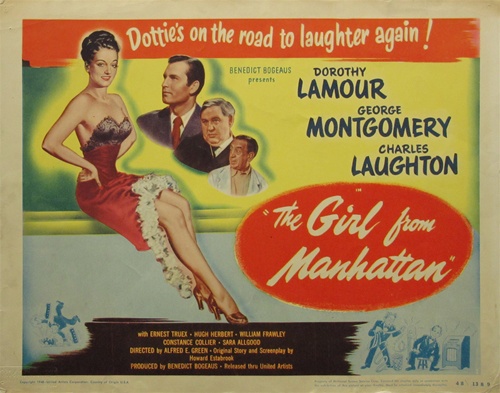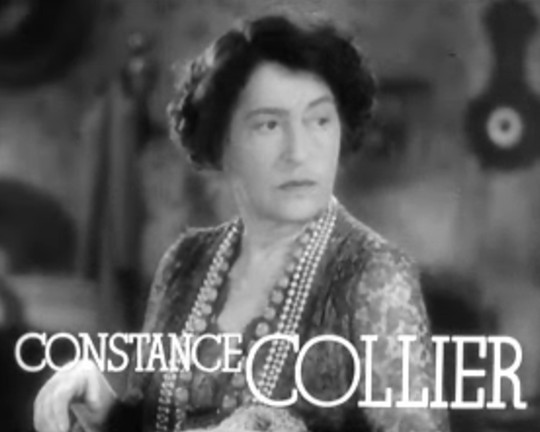Best known as the love-interest/straight woman in a series of Bing Crosby-Bob Hope “Road” movies, Dorothy Lamour gracefully held her own as the level-headed beauty in the midst of the two corny, hyper-kinetic showman. Lamour also had a lovely, romantic singing voice. And you can’t beat her stage name for old-fashioned romance: Dorothy Lamour! So she definitely deserves her place in cinema history.
But it’s probably not fair to ask her to cast her against crack scene-stealer Charles Laughton. In The Girl From Manhattan (1948). They share only one scene, but it’s a master class in what makes acting soar versus what makes it thud. Laughton’s performance as an ornery but ethical bishop is full of entertaining realism— he imbues every line with contrasting textures: imperiousness and sympathy, regret and mischief, judgment and wonder. Plus, Laughton is a virtuoso of stage-business— he’s always eating, drinking, shuffling papers, looking out the window. He’s involved in his world. Lamour, on the other hand, just stands there looking earnest and delivering every line with a tone of polite concern. A perfect a mid-century lady, and about as dull as a pair of white gloves. Do something Dorothy!
But while The Girl From Manhattan fails as a showcase for Dorothy Lamour, it does have other stuff to recommend it: great character actors, lovingly crafted interiors, and a friendly, almost subversive little story. The basic set-up is simple. Dorothy Lamour’s lovable Uncle Homer (Ernest Truex) runs a beat-up boarding house full of eccentric, aging charity cases. One enters radio contests, another writes murder dramas, yet another is building a child-size steam engine in the basement, and so on. While each character actor provides their own convincing brand of starry-eyed obsession, former British stage actress Constance Collier is a standout. She brings real gravitas to her role as an aging performer who wanders about the house declaiming Macbeth or composing scenes for the melodrama she’s writing. Neither intrusive nor self-important, she’s just dignified and hopeful, an utterly likable grande-dame.
While no boarder pays rent, each assures Uncle Homer that their various projects are about to hit the big time. But they aren’t jerks or schemers intentionally out to fleece Uncle Homer. They’re more like a little commune of erratic dreamers, depending on the one guy among them who happens to have real-estate. It’s a pretty ideal retirement community. Instead of staring off into space, waiting for soup and pills, each resident is energetically absorbed in their pet projects. Of course, there’s also some real anxiety behind their frenetic activity. They’re surviving right now, thanks to Uncle Homer, but the future is uncertain. Aging and quirky, they’re probably unemployable. Striking it rich would really mean something to them. Their pipe dreams are their retirement plans.
Into this this curious little community come two paying tenants. Dorothy Lamour, Uncle Homer’s niece, and George Montgomery, novice minister. Lamour is back in Pittsfield to visit Homer and make sure he’s doing alright. Montgomery’s back to find out if he can fill his deceased minister father’s shoes. Both of them left tiny Pittsfield after high-school, planning to make something of themselves. They’ve done alright. Lamour has a fair little modeling career going in New York, while Montgomery made All-American at Yale. But neither have really set the world on fire. And both seem a little lost, a little humbled.
At the boarding house, Lamour and Montgomery recognize each other from their high-school days and a nice little mutual crush begins to brew. Unfortunately, the unfolding romance is kind of prim and dull. The two stand on the boarding house porch and have polite little chats about how they used to see each other at the malt shop (to be fair, they do discover that Lamour once secretly helped him win a fight by smashing a jerky rival in the back while Montgomery hit him from the front. But even in this conversation, there’s no real spark). The couple’s blandness, however, doesn’t ruin the film because The Girl From Manhattan isn’t really about romance. And despite it’s slightly winking title, it really isn’t about Lamour’s big city ways. Lamour and Montgomery, whether they know it or not, have been drawn home because they’re needed—as straight-men. It’s time for them to pick up the mantle of social responsibility. That’s the sometimes boring task of mid-adulthood: You’ve got to be sane, concerned and responsible- especially when those around you are vulnerable and quixotic.
The great crisis in the film hinges on a creepy banker, Mr. Birch (Raymond Largay), who plans to foreclose on Uncle Homer’s boarding house at the end of the month and donate the land for the building of a new church (of course, he’s got a sly plan for making a bunch of money out of this seeming generosity). Homer and his troop are in trouble. If the foreclosure goes through, they’ll be out on the street in a matter of days. Homer braves the coming danger with denial-laced optimism, believing one of his tenants will achieve windfall before the bell tolls. The boarders do try their best. Ever-dignified Collier even tries selling treasured jewelry, but she can’t scrape up more than fifty-dollars—Unfortunately, Homer needs three-thousand, and needs it now.
Niece Lamour scrambles to help. She asks her New York modeling agency for a loan. No dice. Next she begs Montgomery to use his minister’s influence to change the church committee’s building plans, but he doesn’t have enough sway, or nerve, to persuade his parishioners. So she goes to the bishop (Charles Laughton), but he bounces the ball back to Montgomery, saying it’s a parish matter. In the meantime, Montgomery struggles with his conscience: Is he supposed to defy the community’s demand for a newer, more modern church? What will his bishop think? Can he risk going against the grain? Will anyone even listen?
Interestingly, Montgomery’s minister seems to stand less for any specific religion and more for responsibility and kindness. For him, it’s not dogma that matters, what matters is that a gentle, vulnerable (possibly non-churchgoing) community is protected.
Underneath it’s wholesome trappings, The Girl From Manhattan has a subtly rebellious heart. Our bland heroes are two wholesome, well-mannered, clean-living adults. But in standing up to the greed of a banker and the provincial, status-seeking church group in his sway, these two very nice, very conventional people make sure that sure a kooky group of artists, inventors and misfits can keep on living together happily. Rent-free.
(I caught this flick on Amazon Prime…)


